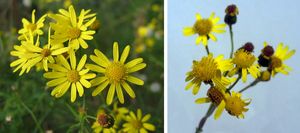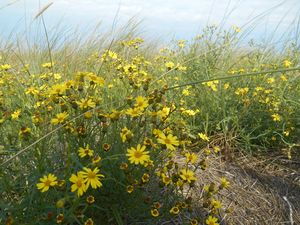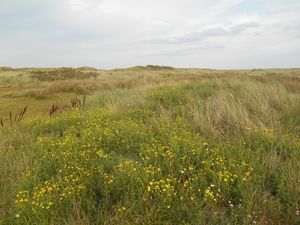Info page Senecio inaequidens (Narrow-leaved ragwort)
What does Senecio inaequidens look like?
 | |
| Fig. 1: Flowers of the narrow-leaved ragwort | |
 | |
| Fig. 2: Narrow-leaved ragwort on the eastern plateau on Spiekeroog (Photo: Laura Schmidt, September 2018) |
Senecio inaequidens grows to a height of 20 - 60 cm and forms so-called semi-shrubs. The plants are strongly branched in the upper third and slightly woody at the base. The leaves are 1 - 3 mm wide and 6 - 7 cm long, linear, with entire margins or finely toothed and often curled at the edges. The flowers are light yellow in colour and 20 - 25 mm in diameter. It flowers from May to December, usually in two flowering phases. In north-west Germany, the first flowers are observed earlier and earlier.
Where does Senecio inaequidens originally come from? Where is it found?
 |
| Fig. 3: Typical stand of narrow-leaved ragwort on the eastern plateau on Spiekeroog (Photo: Laura Schmidt, September 2018) |
Senecio inaequidens originally comes from South Africa and arrived in Europe via woollen imports. This happened in several waves, as the species was initially unable to establish itself permanently. Narrow-leaved ragwort was first found in Germany in Hannover in 1889. Since 1970, it has been spreading eastwards from Belgium and the Netherlands and since 1979, narrow-leaved ragwort has also been found on the East Frisian Islands, where it has also been spreading increasingly in dune habitats since the early 2000s. On the East Frisian Islands, Senecio inaequidens is mainly found in marram grassland and sea buckthorn scrub.
How does Senecio inaequidens spread?
The seeds are spread by the wind. Similar to the dandelion, the seed of Senecio inaequidens has a hair-shaped aerial body. In the stands, "huge quantities of seeds" are formed, which are transported far and wide by air turbulence, especially along motorways, roads and railway tracks, and promote dispersal. Findings far from roads indicate seed transport by other vectors.
How does Senecio inaequidens affect its environment? What does this mean for nature conservation?
To date, there have been no documented cases of harmful effects on other species or habitats caused by Senecio inaequidens, as the growth of narrow-leaved ragwort declines in the course of undisturbed succession. It is exceptionally resistant to herbicides and tolerates mowing very well.
Can Senecio inaequidens be confused with native plants?
There are herbs that are native to Germany, such as the Common groundsel (Senecio vulgaris). It is usually easy to recognise them by their leaves.
On the East Frisian Islands, Senecio erucifolius is often found in the immediate vicinity of the common ragwort, which can easily be confused with it without closer inspection.
Countermeasures
As no or only minor effects on the environment are known, there is currently no need for action. The development of populations in coastal dunes should be monitored.
What can you do if you find Senecio inaequidens in the wild?
The entire plant is poisonous! Please leave it standing and do not touch it. If you do come into contact with it, wash the affected areas thoroughly.
Own work
Neophyten auf der Insel Wangerooge - Bestandsaufnahme und Gefährdungspotenzial am Beispiel der Kartoffelrose, der Späten Traubenkirsche und des Schmalblättrigen Greiskrauts. Diplomarbeit von Sven Oltrop, Universität Oldenburg, November 2010.
Contact
If you have any questions, please contact:
Dr. Markus Prinz: markus.prinz[at]uni-oldenburg.de
or PD Dr Holger Freund: holger.freund[at]uni-oldenburg.de

![[Translate to English:]](/f/5/_processed_/3/2/csm_ICBM-Logo-transparent-_91fe1c6774.png)